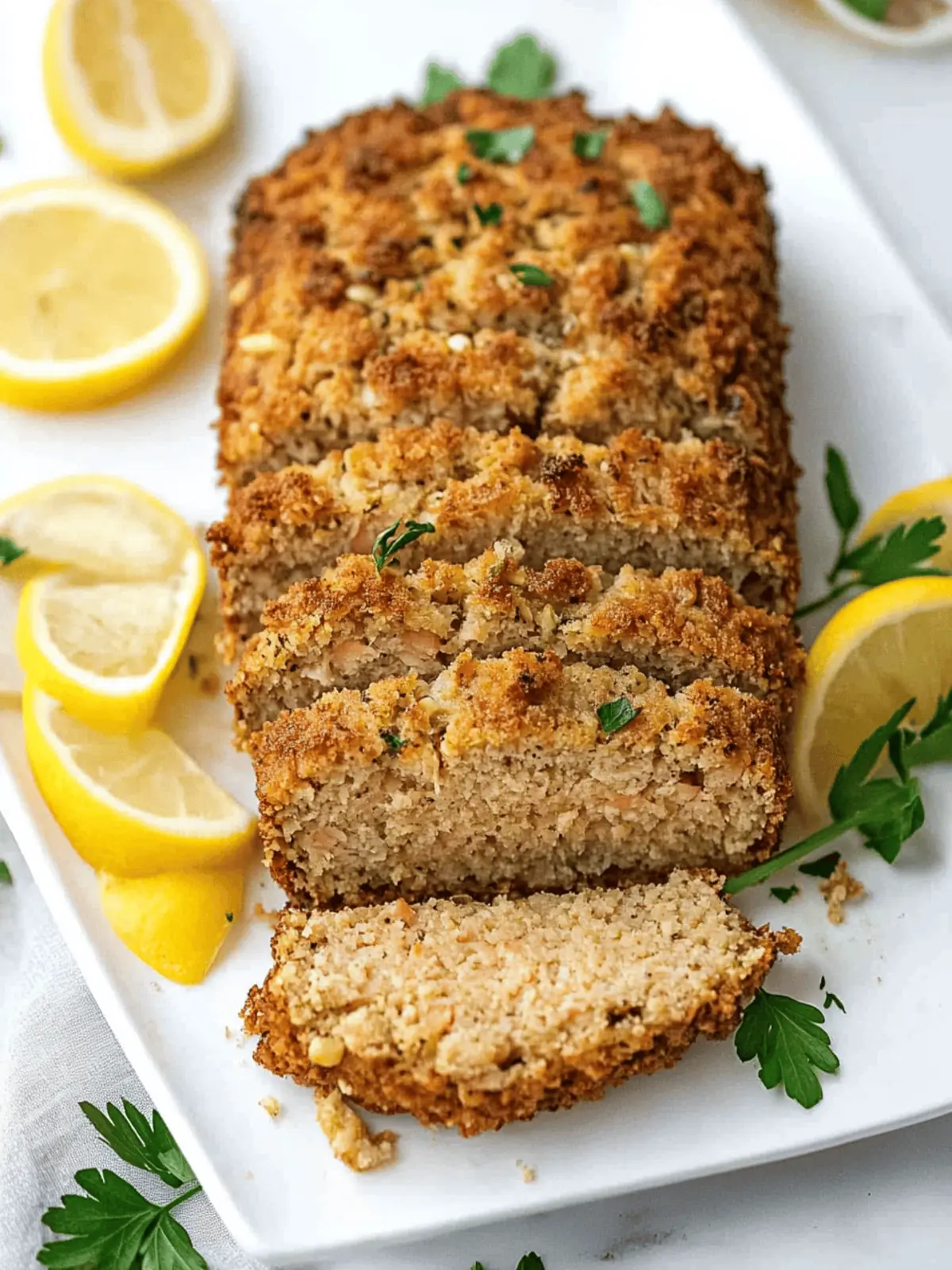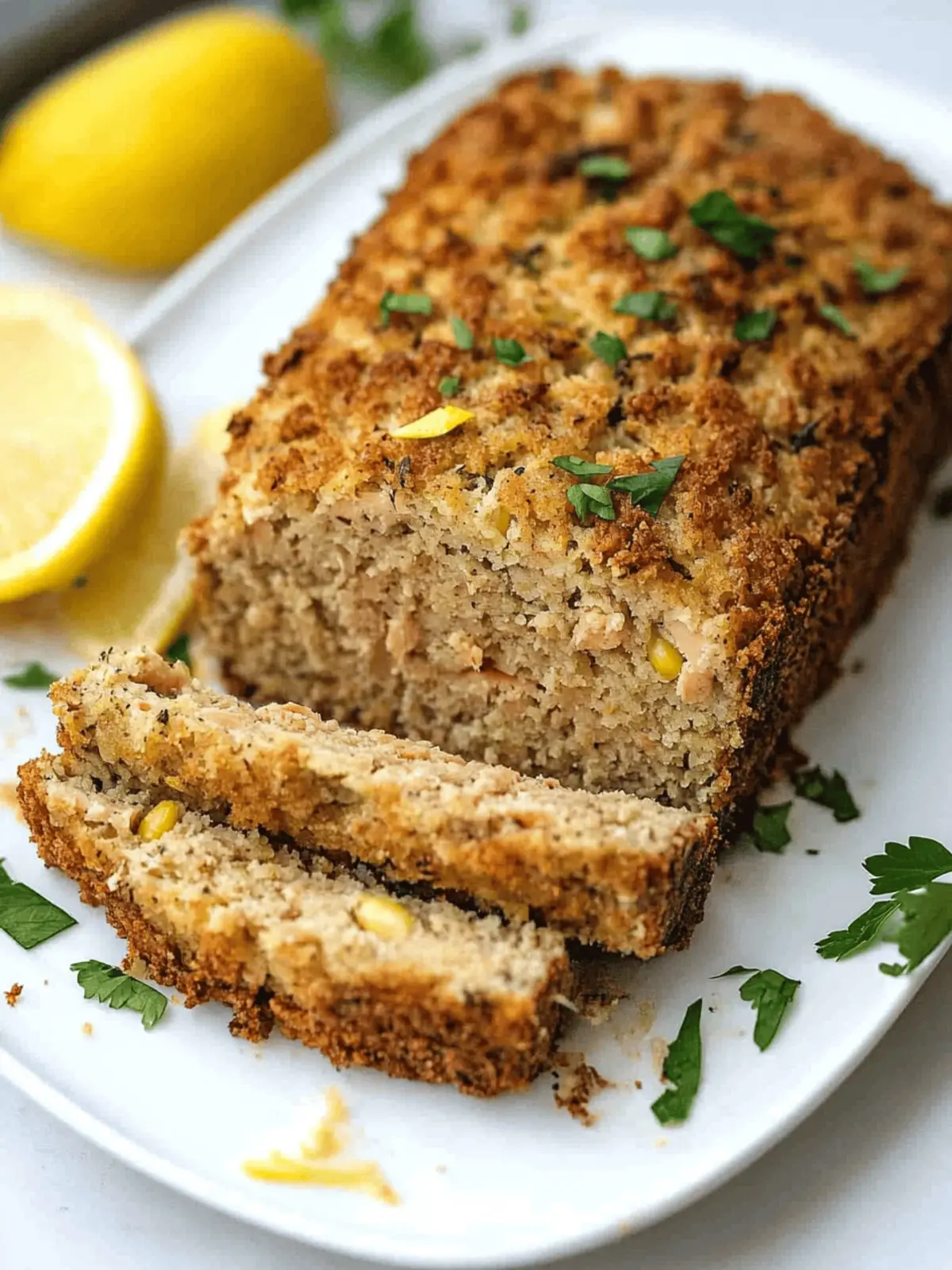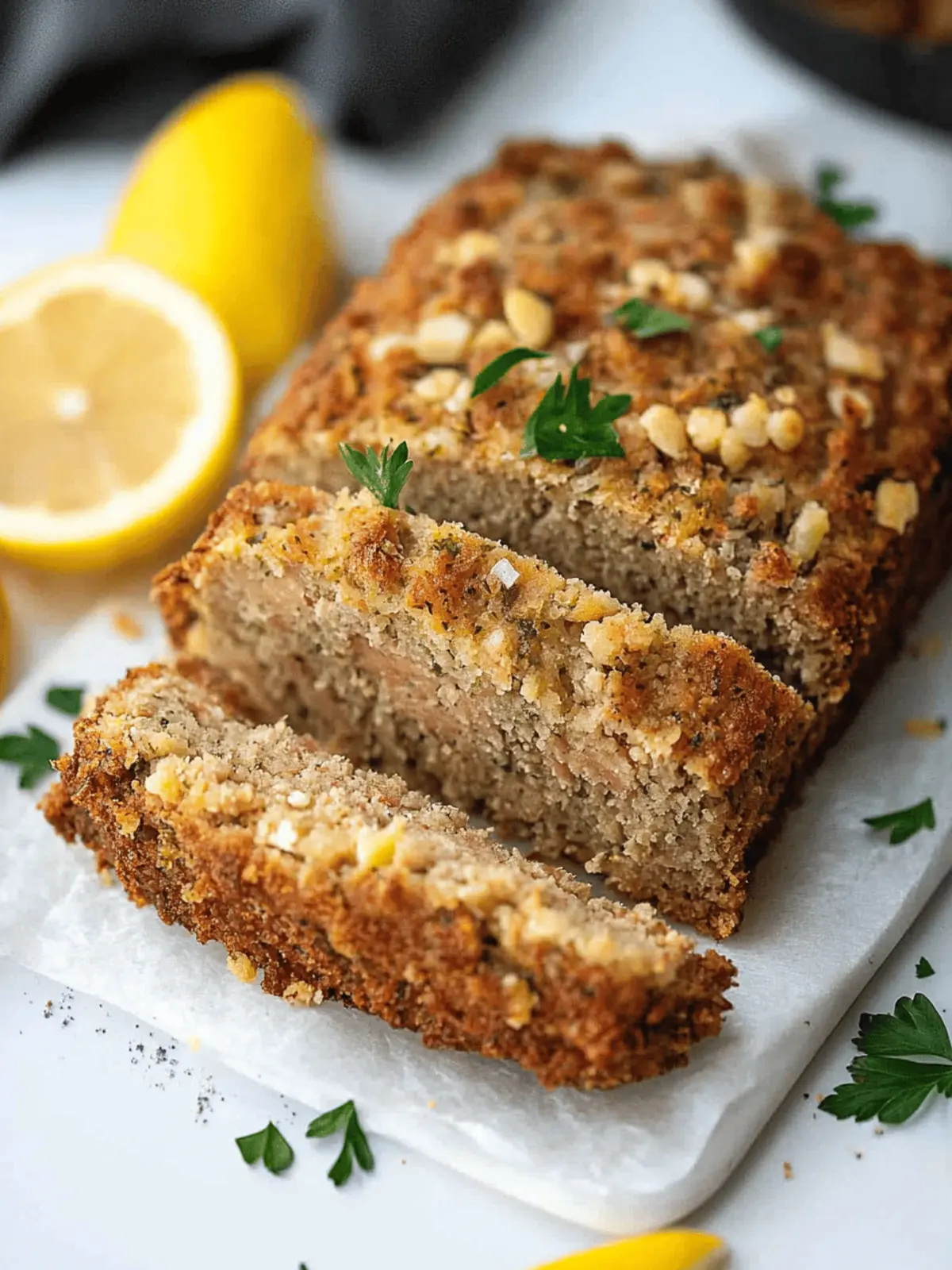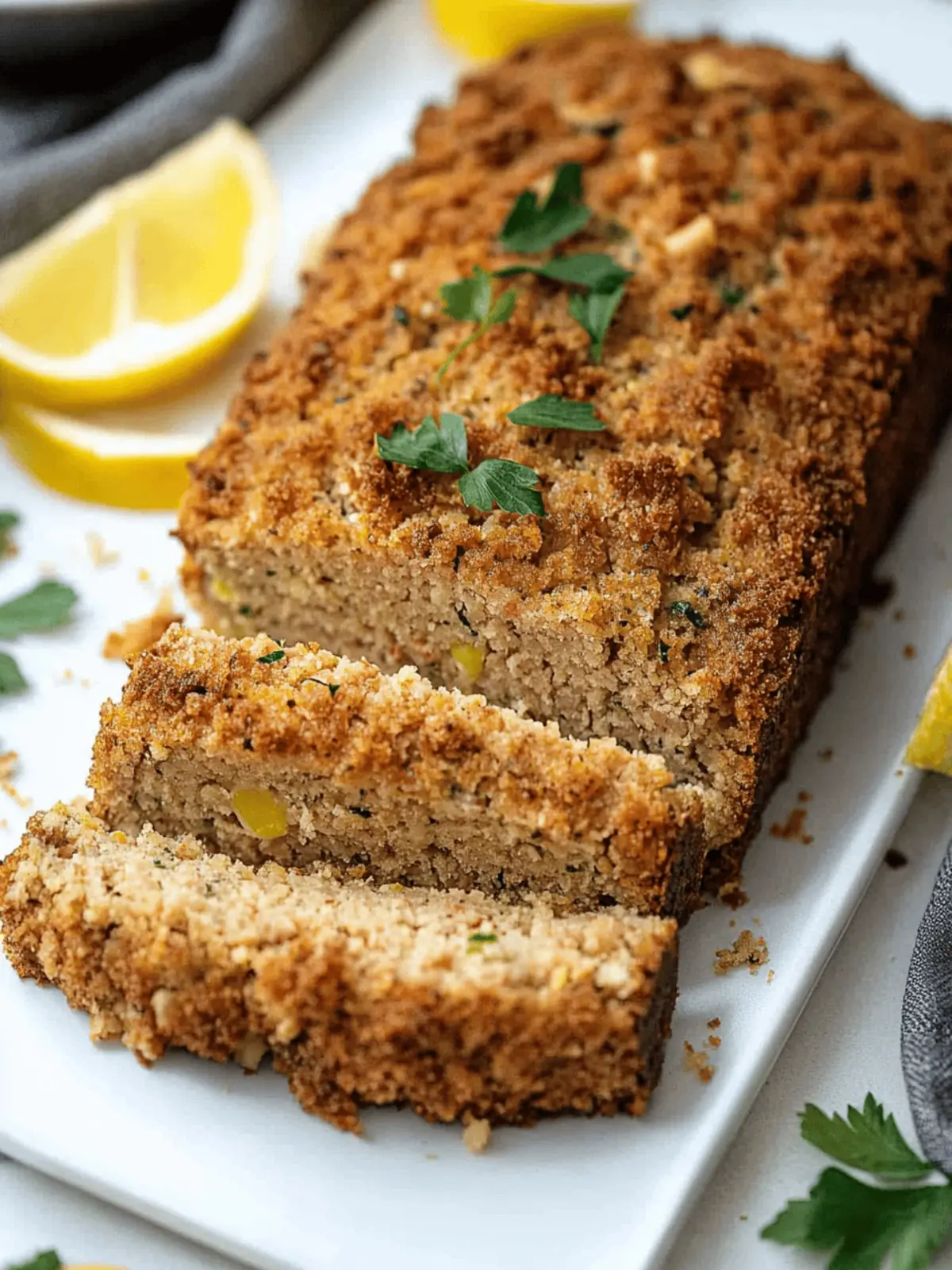There’s something comforting about the blend of savory flavors and flaky texture that a good salmon loaf brings to the table. I stumbled upon this delightful dish during a rainy afternoon when I was searching for a way to transform a humble can of salmon into something truly special. Little did I know that, with just a handful of ingredients, I could create a dish that would not only satisfy my cravings but also impress my family.
This Salmon Loaf is incredibly easy to make yet packs a punch in both flavor and nutrition. Whether you’re trying to break free from the clutches of fast food or simply looking to impress guests with a homemade meal, this recipe fits the bill. With its crispy edges and tender center, it’s the perfect centerpiece for a cozy dinner. Plus, it’s versatile enough to enjoy warm or cold, making leftovers a delight!
Join me in crafting this simple yet delicious salmon loaf that’s sure to become a new staple in your kitchen. Let’s dive into the recipe that brings comforting home-cooked goodness to any meal!
Why is Salmon Loaf a Family Favorite?
Versatility: This recipe works perfectly for lunch, dinner, or even a picnic!
Simple Preparation: With just a few ingredients, you’ll have a delicious dish ready in no time.
Nutrient-Dense: Packed with protein and omega-3 fatty acids, it’s a healthy choice that doesn’t compromise on flavor.
Crowd-Pleasing: Kids and adults alike adore this savory delight, making it a great option for family meals.
Need a side dish? Try serving it with a fresh salad or some roasted vegetables from your favorite simple side dish recipes.
Leftover Love: The flavors deepen when stored, making for delightful next-day meals!
Salmon Loaf Ingredients
• Discover the key components for a delightful Salmon Loaf!
For the Base
- 16 ounces canned salmon – choose high-quality salmon for a richer flavor.
- 1 cup seasoned fine breadcrumbs – these add texture and help bind the loaf together.
- ½ cup onion, finely chopped – enhances flavor; try using shallots for a sweeter taste.
- 1 tsp dill weed – a classic herb that complements the salmon beautifully.
For the Mixture
- ½ cup milk – helps to keep the loaf moist; can be substituted with almond milk for a dairy-free version.
- 2 large eggs, beaten – acts as a binding agent for a cohesive loaf.
- 1 tablespoon lemon juice – brightens the flavors; fresh lemon zest can add an extra zing.
For Seasoning
- ½ tsp salt – essential for taste; adjust based on your dietary preferences.
- ¼ tsp black pepper – adds a subtle kick; feel free to add more for heat!
Embrace the delightful flavors of this Salmon Loaf and bring your family together with a warm, homemade dish!
How to Make Salmon Loaf
-
Preheat your oven to 375°F. This ensures even cooking, so your loaf turns out perfectly golden and moist. Grease a baking sheet lightly and have it ready for your salmon mixture.
-
Drain the salmon thoroughly. If you prefer, remove any skin and bones to make it easier to eat. This step helps achieve a smoother texture in your loaf.
-
Flake the salmon with a fork in a mixing bowl. Next, mix in the breadcrumbs, chopped onion, milk, dill, beaten eggs, lemon juice, salt, and pepper. Combine everything until mixed but avoid over-mixing—your salmon loaf will be tender!
-
Shape the mixture into a loaf form on your greased baking sheet. Make sure it’s nicely compact but not overly pressed; you want it to maintain a bit of fluffiness while baking!
-
Bake the salmon loaf for 40-50 minutes. Keep an eye on it; you’re looking for a nicely browned top and an internal temperature of at least 165°F for safe eating.
-
Cool for 5 minutes once removed from the oven. This allows the loaf to set. Slice it gently and serve warm, garnished with fresh parsley and lemon wedges for a delightful presentation!
Optional: Enjoy with a splash of hot sauce for an extra kick!
Exact quantities are listed in the recipe card below.
Make Ahead Options
These Salmon Loaf options are perfect for busy home cooks looking to save time during hectic weeknights! You can prepare the salmon mixture (steps 2-3) and refrigerate it for up to 24 hours before baking. This not only saves you precious time but allows the flavors to meld beautifully, enhancing the dish. To maintain quality, make sure to store it in an airtight container to prevent drying. When you’re ready to serve, simply shape it into a loaf on the baking sheet and bake as directed (step 5). You’ll enjoy the same delightful flavors and textures while spending less time in the kitchen!
What to Serve with Salmon Loaf?
A mouthwatering salmon loaf deserves flavorful companions to create a memorable meal experience.
-
Crispy Roasted Potatoes: Their golden, crunchy exterior and fluffy interior contrast beautifully with the loaf’s soft texture. Season them with garlic and rosemary for added zest!
-
Garden Salad: A fresh mix of greens and vibrant vegetables adds a refreshing touch. Toss with a lemon vinaigrette to echo the loaf’s citrus notes.
-
Steamed Asparagus: Tender yet crisp, asparagus brings elegance to the plate. Drizzling with a bit of olive oil and lemon juice enhances its natural flavor.
-
Creamy Coleslaw: The crunchy cabbage and creamy dressing provide a delightful texture balance. Each bite will make your salmon loaf even more exciting.
-
Savory Cornbread: A slice of warm cornbread with a hint of sweetness makes for comforting side. Its moisture pairs perfectly, complementing the loaf’s savory essence.
-
Herbed Quinoa: Fluffy quinoa tossed with fresh herbs is a nutritious and flavorful option. It absorbs the aromas of the salmon loaf while enhancing the meal’s overall heartiness.
-
Chardonnay: A chilled glass of Chardonnay beautifully complements the flavors of salmon. Its crisp acidity highlights the loaf’s savory, lemony elements and elevates the dining experience.
How to Store and Freeze Salmon Loaf
Fridge: Store leftover salmon loaf in an airtight container for up to 3 days to maintain freshness and flavor.
Freezer: For longer storage, wrap the cooled salmon loaf tightly in plastic wrap and then again in aluminum foil. It can be frozen for up to 2 months.
Reheating: To reheat, bake in the oven at 350°F until warmed through, about 15-20 minutes. Enjoy it as a comforting meal that tastes just as good as the first time!
Leftover Love: The flavors of the salmon loaf deepen over time, making it a delightful treat for the next day!
Salmon Loaf Variations
Feel free to personalize your salmon loaf with these fun and tasty twists!
- Dairy-Free: Substitute milk with almond or oat milk for a creamy texture without dairy.
- Herb Infusion: Add fresh parsley or chives to elevate the flavor with a fresh burst. These herbs give a garden-like freshness that makes every bite special.
- Spicy Kick: Incorporate diced jalapeños or a dash of cayenne pepper for a delightful heat that warms up your taste buds. It’s perfect for those who love a little fire!
- Vegetable Boost: Mix in finely chopped bell peppers or spinach to add color, nutrition, and additional flavor to your loaf. The extra veggies create a beautiful, vibrant dish.
- Smoky Flavor: Add a teaspoon of smoked paprika to introduce a delicious depth of flavor. This twist transforms your loaf into a smoky delight that will have you craving more.
- Whole Grain: Swap seasoned breadcrumbs for whole wheat or crushed crackers for added fiber and texture. It’s a subtle change that enhances the overall heartiness of the dish.
- Zesty Citrus: Replace lemon juice with lime or orange juice for a different citrus twist, creating an enticingly bright flavor profile. Try it for a refreshing change that surprises the palate!
- Cheesy Twist: Fold in crumbled feta or shredded cheese for an indulgent, creamy texture. This creates a rich, flavorful loaf that feels like a warm hug in every bite.
Expert Tips for Salmon Loaf
Quality Matters: Use high-quality canned salmon for the best flavor and texture; it will make your salmon loaf truly shine.
Moisture Check: Don’t skip the milk! It keeps the loaf moist. If it feels too dry, a splash more can help.
Avoid Overmixing: Combine ingredients gently. Overmixing can result in a dense loaf instead of that delightful flaky texture.
Check Temperature: Use a meat thermometer to ensure your salmon loaf reaches an internal temperature of 165°F for perfect doneness.
Cool Before Slicing: Let the salmon loaf rest for 5 minutes after baking. This helps it set and prevents crumbling while slicing.
Creative Leftovers: Transform leftover salmon loaf into sandwiches or salads for delicious meals throughout the week!
Salmon Loaf Recipe FAQs
What type of canned salmon should I use?
Absolutely! For the best flavor and texture, I recommend using high-quality canned salmon. Look for wild-caught varieties if possible, as they often have a richer taste and better nutritional profile.
How should I store leftover salmon loaf?
To keep your salmon loaf fresh, place it in an airtight container and store it in the refrigerator for up to 3 days. Make sure it’s completely cooled before sealing it up to maintain the best flavor and texture.
Can I freeze salmon loaf?
Very! To freeze your salmon loaf, let it cool completely after baking. Then, wrap it tightly in plastic wrap and again in aluminum foil. This double-wrapping will help prevent freezer burn. Properly stored, it can last for up to 2 months in the freezer.
How do I reheat frozen salmon loaf?
Reheating is simple! Preheat your oven to 350°F. Remove the salmon loaf from the freezer and unwrap it. Place it in an oven-safe dish, cover it with foil to keep it moist, and bake for about 15-20 minutes or until heated through. This keeps the loaf delicious and juicy!
Is salmon loaf safe for pets?
Generally, plain cooked salmon can be a safe treat for dogs, but it’s wise to avoid any added ingredients like onions or excessive salt and spices. Always consult your vet for specific dietary guidelines for your pets.
What should I do if my salmon loaf is too dry?
If you find your salmon loaf is on the dry side, it might be due to overbaking or the type of breadcrumbs used. Next time, try adding a bit more milk to the mixture, or consider using fresh breadcrumbs instead of dry ones. Also, make sure to monitor the baking time to avoid drying it out!

Savory Salmon Loaf: A Flavorful Twist on Comfort Food
Ingredients
Equipment
Method
- Preheat your oven to 375°F. This ensures even cooking, so your loaf turns out perfectly golden and moist. Grease a baking sheet lightly and have it ready for your salmon mixture.
- Drain the salmon thoroughly. If you prefer, remove any skin and bones to make it easier to eat. This step helps achieve a smoother texture in your loaf.
- Flake the salmon with a fork in a mixing bowl. Next, mix in the breadcrumbs, chopped onion, milk, dill, beaten eggs, lemon juice, salt, and pepper. Combine everything until mixed but avoid over-mixing—your salmon loaf will be tender!
- Shape the mixture into a loaf form on your greased baking sheet. Make sure it’s nicely compact but not overly pressed; you want it to maintain a bit of fluffiness while baking!
- Bake the salmon loaf for 40-50 minutes. Keep an eye on it; you're looking for a nicely browned top and an internal temperature of at least 165°F for safe eating.
- Cool for 5 minutes once removed from the oven. This allows the loaf to set. Slice it gently and serve warm, garnished with fresh parsley and lemon wedges for a delightful presentation!








